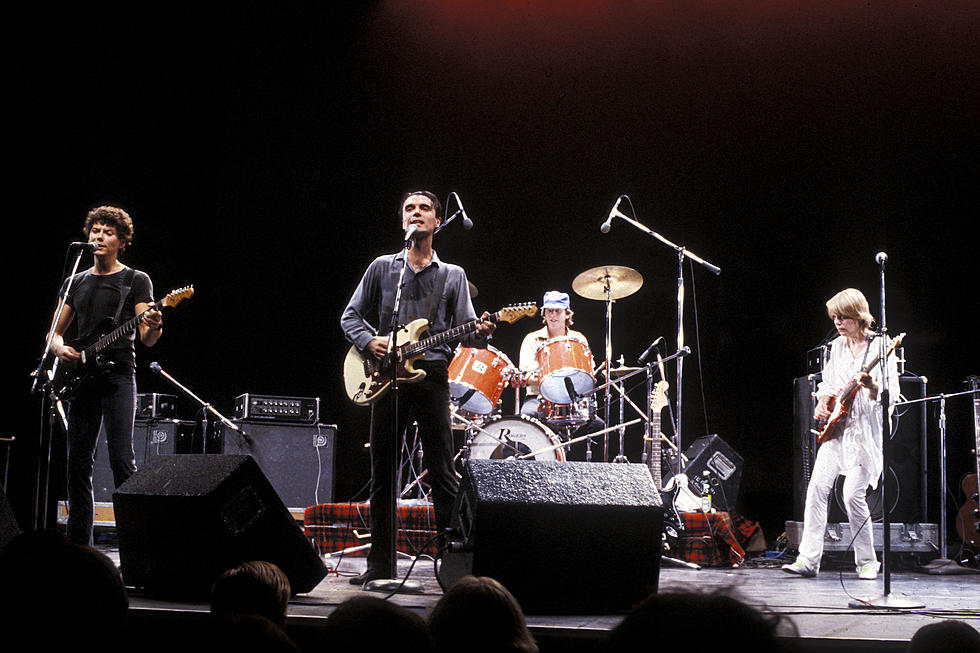
The Story of Talking Heads’ Masterpiece, ‘Remain in Light’
The seeds of Talking Heads' landmark Remain in Light album were planted on the band's previous record, 1979's Fear of Music. But the year away from the studio, plus a change of locale for basic recording, made a world of difference in the end.
Talking Heads went into their fourth album with the intention of proving once and for all that they were a band; they emerged as a different entity, continuing on this same path for the rest of their too-brief career.
Following the release of Fear of Music in August 1979 – their most successful album yet in a two-year span that was continually yielding bigger sales figures and more fans – Talking Heads were, more and more as time went on, hearing that David Byrne was essentially a gifted but eccentric frontman taking charge of the three musicians who happened to play on his records. The band, with producer Brian Eno on board, set out to prove that they were four singular minds driving toward one shared purpose.
So, they tightened up. They got funky. They set up shop in Nassau. They surrounded Remain in Light's eight songs with a worldly blend of global pop, post-punk, American R&B and artsy experimentalism augmented by a handful of session players on horns and percussion. And they played around with loops and samples, still mostly unheard of at the time, which gave the album the otherworldly feeling that the entire project was shipped in from another time and place, nowhere near the end-of-the-century New York City that the group had come to identify with so closely.
But it's not such a dramatic leap that the dots can't be connected between Fear of Music and Remain in Light, which followed on Oct. 8, 1980. In fact, "I Zimbra," from the former, was a launching point for the latter, with the band members jamming on the song, seeing where it would take them. Along with Byrne's recent collaborations with Eno, which would be released in 1981 as My Life in the Bush of Ghosts, it served as both an expansion to the group's previous work and an opening to a brave new world.
Listen to the Talking Heads Perform 'Once in a Lifetime'
Inspired by Nigerian Afrobeat legend Fela Kuti, the music on Remain in Light took on a more jam-based and fluid approach. Hip-hop, which began creeping into NYC culture at the time, also left its mark, as the eight tracks shifted, twisted and transformed into new shapes at every turn. As influential as it was revolutionary, the LP charted new musical territory for anyone interested in the sound of a dozen genres colliding and then coming together.
From the opening "Born Under Punches (The Heat Goes On)," featuring a particularly elastic bass line by Tina Weymouth, and the frenetic "Crosseyed and Painless" to "Once in a Lifetime," which received tons of MTV airplay, and the New-Wave-meets-world-music "Houses in Motion," Remain in Light unfolds as a singular piece of pop music on an entirely different plain. No other record released in 1980 sounded like it; all these years later, artists are still trying to catch up.
Lyrically, the album drifted into original territory too, with Byrne combing a mix of his existential, stream-of-conscious and art-school playbooks to come up with a work that defied expectation and circumvented explanation. As he sings on "Once in a Lifetime," "You may ask yourself, How did I get here?" There's no easy answer, but the album changed Talking Heads forever.
The album reached No. 19, and set up the group for its breakthrough with its next LP, 1983's Speaking in Tongues, which included Talking Heads' only Top 10 hit "Burning Down the House." That then spawned a popular tour that was later documented in the movie and album Stop Making Sense.
The musical ideas laid out on Remain in Light provided the foundation for Talking Heads' crisscrossing into other genres (including Americana and straightforward rock 'n' roll) before leadership issues – which were never smoothed over – led to their breakup in 1991.
Top 100 '80s Rock Albums
More From Ultimate Classic Rock









